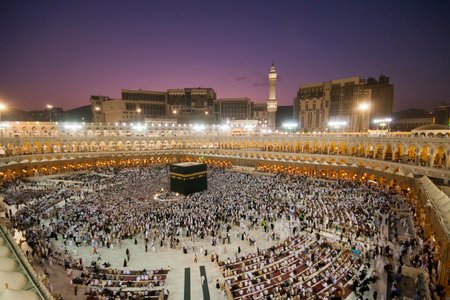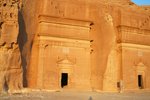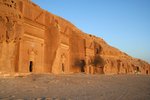Hajj is a pilgrimage to
Mecca - Islam's holiest city. All Muslims must perform this pilgrimage
as an act of worship at least once in his/her lifetime. Performed
during the Islamic month of Dhul-Hijjah, and lasting 5-days,
Hajj is a series of ritual acts, which symbolize the lives
of Abraham and his son Ishmael.
Sequence of the Hajj Journey:
Day 1
Ihram: Before entering the Holy city of Mecca, the pilgrim must first perform a ritual cleansing and wear special Ihram garments, which consist of two unhemmed white sheets. In doing so, the pilgrim declares their intention abstain from the restricted acts, such as using perfume, trimming their nails, or sexual intercourse.
Umrah: Once in Mecca, the pilgrims enter the The Sacred Mosque (Masjid Al Haram). In the centre of the Mosque stands a cubic building 15 meters (49 ft) high and 10 meters (33 ft) wide. This, the Kaaba, was built by Abraham and Ishmael as a house of worship, and is considered the center of the Muslim world. Embedded in the South Eastern corner of the Kaaba is the black stone (al-Hajar-ul-Aswad), which is believed to have fallen from heaven and turned black from the absorption of sin.
Entering the Mosque, the pilgrims perform their first Tawaf.
In a Tawaf, the pilgrims circle the Kaaba seven times and
kiss the black stone on each rotation. After Tawaf, on the same day, the
pilgrims perform sa'i, running or walking seven times
between the hills of Safa and Marwah, which are 450 meters
(492 yards) apart. This is a re-enactment of Hagar's
(Abraham's wife) frantic search for water for their son
Ishmael, before an angel revealed to her the ZamZam Well.
Day 2
Arafat: On the second day of Hajj, the pilgrims travel 14.4 km (9 miles) east from Mina to Mount Arafat - the place of the last sermon of the profit Muhammad. Considered the culminating experience of Hajj, pilgrims spend the afternoon in contemplative vigil. From afternoon to sunset, they stand, in prayer and reflection, facing Mecca. In the evening after Arafat, pilgrims leave for Muzdalifah, traveling 9 km (5.6 miles).
Muzdalifah: At Muzdalifah, which is located between Arafat and Mina, the pilgrims sleep in the open (i.e., without tents). They spend the night in prayer and gathering stones for the next day's ritual "stoning of the devil." Before the sun has risen, the pilgrims return to Mina.
Day 3
Ramy al-jamarāt: On the third day, in Mina, pilgrims perform the stoning of the devil (ramy) where they throw their stone pebbles at the largest of three Jamarat pillars. The Jamarat pillars represent the temptations of Satan. After the stoning, an animal is sacrificed, either by the pilgrim or by someone appointed by the pilgrim to perform the sacrifice in their name.
Tawaf al-Ifadah: Returning to Mecca on the same day, Pilgrims revisit The Sacred Mosque for an additional Tawaf, called Tawaf al-Ifadah, which symbolizes being in a hurry to respond to God, an obligatory part of the Hajj.
As a final sacrifice, the pilgrim then shaves his/her head
or cuts off a portion of hair. Following this act, all of
the restrictions of Ihram are lifted, meaning that they can
wear everyday clothing, wear perfume, etc.
Day 4 / 5
The Days of Tashriq: The pilgrims then return to Mina for two days. On each of the two days, pilgrims, again, stone the Jamarat pillars, each with seven stones. These two days are spent in contemplative prayer.
On the fifth day, pilgrims return to Mecca where a Farewell
Tawaf is performed and the Hajj is complete.






